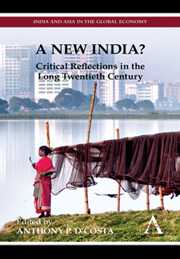Book contents
- Frontmatter
- Contents
- List of Tables and Figures
- Foreword by Deepak Nayyar
- Preface and Acknowledgements
- Chapter 1 What is this ‘New’ India? An Introduction
- Chapter 2 New Interpretations of India's Economic Growth in the Twentieth Century
- Chapter 3 Continuity and Change: Notes on Agriculture in ‘New India’
- Chapter 4 An Uneasy Coexistence: The New and the Old in Indian Industry and Services
- Chapter 5 Is the New India Bypassing Women? Gendered Implications of India's Growth
- Chapter 6 The ‘New’ Non-Residents of India: A Short History of the NRI
- Chapter 7 Revivalism, Modernism and Internationalism: Finding the Old in the New India
- Chapter 8 Creative Tensions: Contemporary Fine Art in the ‘New’ India
- List of Contributors
- Index
Foreword by Deepak Nayyar
Published online by Cambridge University Press: 05 March 2012
- Frontmatter
- Contents
- List of Tables and Figures
- Foreword by Deepak Nayyar
- Preface and Acknowledgements
- Chapter 1 What is this ‘New’ India? An Introduction
- Chapter 2 New Interpretations of India's Economic Growth in the Twentieth Century
- Chapter 3 Continuity and Change: Notes on Agriculture in ‘New India’
- Chapter 4 An Uneasy Coexistence: The New and the Old in Indian Industry and Services
- Chapter 5 Is the New India Bypassing Women? Gendered Implications of India's Growth
- Chapter 6 The ‘New’ Non-Residents of India: A Short History of the NRI
- Chapter 7 Revivalism, Modernism and Internationalism: Finding the Old in the New India
- Chapter 8 Creative Tensions: Contemporary Fine Art in the ‘New’ India
- List of Contributors
- Index
Summary
At the end of the first decade of the twenty-first century, there is a striking optimism about the emerging India. The country that only had a past is beginning to be seen as a country with a future. The land of scarcities is being thought of as a land of opportunities. The land of snake charmers is now considered a land of fashion designers. The land of traditional crafts is increasingly perceived as a land of information technology. The land of bullock carts or steam trains is beginning to be seen as a land of automobiles or jet planes. This dramatic change of mood is particularly discernible among the rich and the literati in India. There is a similar change in thinking about India in the outside world, mostly among interested individuals or concerned institutions. The mood is contagious, and the images are larger than life, because those who articulate such views have both voice and influence.
It would seem that perceptions about India are changing rapidly. The realities are also changing, but much more slowly. And there is a mismatch. The perceptions, as also the realities, depend on who you are, what you do and where you live. Captains of industry, editors of newspapers or ministers of governments see one India. So does the software engineer in Bangalore, the stockbroker in Mumbai, the lobbyist in Delhi or the entrepreneur in provincial India.
- Type
- Chapter
- Information
- A New India?Critical Reflections in the Long Twentieth Century, pp. xi - xviPublisher: Anthem PressPrint publication year: 2010
- 2
- Cited by



